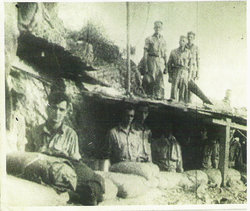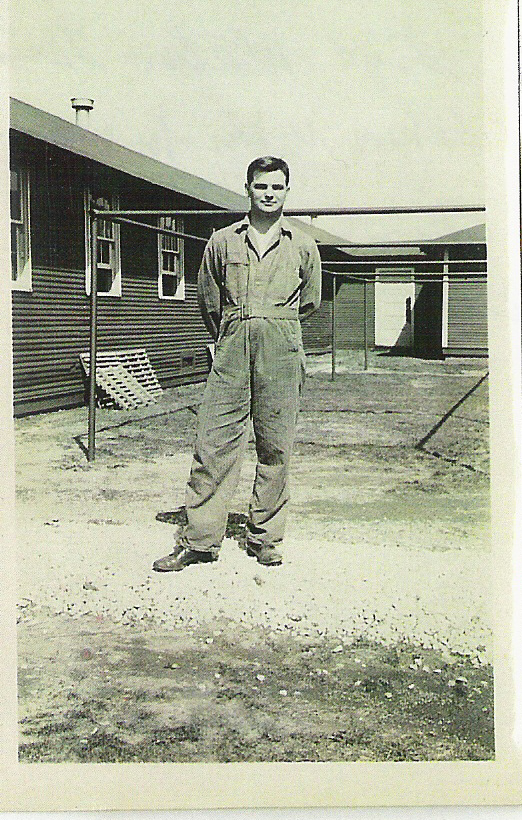Name: Thrasher
Father: Earnest
Mother: Mattie H Freese
County: Monroe
Gender: Male
Birth Date: 28 Mar 1917
Reference: Monroe County Indiana Index to Birth Records 1882 - 1920 Inclusive Letters A - Z Inclusive
Book: CH-28
Page: 632
William H. Thrasher of Monroe County Indiana was killed September 7, 1944, while serving in the South Pacific during World War II. He is officially listed as missing or buried at sea and his name appears on the "Tablets of the Missing" at the Manila American Cemetery in the Philippines.
Staff Sergeant William H. Thrasher of Bloomington, Indiana and the 28th Bomber Squadron, 19th Bomber Group Heavy was killed in action in the South Pacific September 7, 1944 Reference August 12, 1942 Missing in Action Page 11, Column 4
From the Bloomington Herald Times of October 19, 2003:
"Family's joy turns to sorrow for Bloomington World War II soldier. As the world rejoiced in the surrender of Japan on Aug. 14, 1945, the tragedy of World War II remained heavy around the hearths of tens of thousands of American homes. The home of Mrs. Helen Thrasher, in Bloomington, was one of those. To the bitter waste of war, the Thrasher home had lost a son and brother emdash Bill. Incredibly, while a prisoner of the Japanese, he died at the hands of his own American comrades. Stationed at Clark Field in the Philippines when the Japanese attacked Pearl Harbor on Dec. 7, 1941, Bill and his unit emdash the 28th Bombardment Squadron of the Army Air Corps emdash were ordered to the defense of Corregidor. On May 6, 1942, the remnants of that fighting force, 11,000 American and Filipino troops, surrendered to an overwhelming 56,000-man enemy force, marking the end of organized American resistance in the Philippines. The gallant defenders of Corregidor were herded with other captives and together they made up the 40,000 souls forced on the infamous 'Bataan Death March.' On the long trek to prisons more than 70 miles away, more than half their number died from starvation, maltreatment and cold-blooded murder. After the fall of Corregidor, Bill's mother was notified by the War Department that he was missing in action and presumed dead. Hope for his safety, however, never died in the Thrasher home, and, as was the custom in those uncertain days, they followed the course of the war not only by newspaper and radio in the home, but also by viewing newsreels in the movie theaters. On Mother's Day 1943, Mrs. Thrasher and her daughter, Esther Conard, Bill's sister, went to the Indiana Theater to see the current newsreel. It was so crowded they had to sit in separate seats a good distance apart. When the newsreel came on and a captured Japanese film of American war prisoners was shown, Esther thought she saw Bill in it. She jumped from her seat and ran out of the theater. Her mother had also seen Bill, and she, too, ran out of the theater and met her daughter outside. They compared impressions and they were certain that the image on the screen was that of their son and brother, Bill. For Mrs. Thrasher, who was nearing her 89th birthday, the emotional effect of seeing her son on screen was almost more than she could bear. The owners of the theater reserved seats for the Thrasher family for 11 consecutive showings of the same newsreel, until it was agreed that it was Bill on film, that he was truly alive, and that he was in the hands of the Japanese. Bloomington shared the Thrashers' joy, for Bill had been a popular football player and wrestler at Bloomington High School. Letters of inquiry from the Thrashers to the Japanese were returned time and again until, finally, a card was received from the Imperial Japanese Army at Philippine Military Prison Camp 2, stating in typewritten words that Bill was 'well' and, 'I hope you don't worry about me. We don't have the comforts of home, but I'm used to it all now.' Fourteen months of clinging to hope had paid off for the Thrashers. Bill was still alive. His brother, Philip E. (Phip) Thrasher, at sea in the Pacific, was given the good news. The Thrashers and Bloomington thanked God. Bill had indeed survived Corregidor, the Bataan Death March, and only God knows what else. In time, the war in the Pacific went against the Japanese. The American people, their ingenuity, their all-out-effort in work-power and bond-buying, made good Gen. Douglas MacArthur's promise to the Filipino people. And it was his 'return' to the Philippines on Oct. 20, 1944, backed by scores of thousands of fighting men, that turned the Thrashers' joy into a nightmare of disbelief. Retreating before U.S. troops, losing the ground, air and sea wars, Japanese forces vacated one stronghold after another, literally pushed by U.S. forces into the seas around the Philippines and throughout the Pacific. Philippine Military Prison Camp 2 was no exception, and Bill and those prisoners with him were moved. On Sept. 7, 1944, Bill was one of 750 prisoners of war being transferred aboard the unmarked Japanese 'Hell Ship,' which had sailed earlier from Davao, Mindanao, Aug. 20. As the vessel steamed off of Zamboango, she was torpedoed and sunk by an American submarine. 'The indications are,' wrote Maj. Gen. J. H. Ulio of the U. S. War Department to Mrs. Thrasher in March 1945, 'that relatively few of the prisoners had an opportunity to leave the sinking ship, and of those who did, many were killed by enemy fire. A small number managed to reach shore.' After months of hoping that he may have been among those who made it to shore, that he would one day return, the Thrashers finally resigned themselves to the irony of Bill's death."
Name: Thrasher
Father: Earnest
Mother: Mattie H Freese
County: Monroe
Gender: Male
Birth Date: 28 Mar 1917
Reference: Monroe County Indiana Index to Birth Records 1882 - 1920 Inclusive Letters A - Z Inclusive
Book: CH-28
Page: 632
William H. Thrasher of Monroe County Indiana was killed September 7, 1944, while serving in the South Pacific during World War II. He is officially listed as missing or buried at sea and his name appears on the "Tablets of the Missing" at the Manila American Cemetery in the Philippines.
Staff Sergeant William H. Thrasher of Bloomington, Indiana and the 28th Bomber Squadron, 19th Bomber Group Heavy was killed in action in the South Pacific September 7, 1944 Reference August 12, 1942 Missing in Action Page 11, Column 4
From the Bloomington Herald Times of October 19, 2003:
"Family's joy turns to sorrow for Bloomington World War II soldier. As the world rejoiced in the surrender of Japan on Aug. 14, 1945, the tragedy of World War II remained heavy around the hearths of tens of thousands of American homes. The home of Mrs. Helen Thrasher, in Bloomington, was one of those. To the bitter waste of war, the Thrasher home had lost a son and brother emdash Bill. Incredibly, while a prisoner of the Japanese, he died at the hands of his own American comrades. Stationed at Clark Field in the Philippines when the Japanese attacked Pearl Harbor on Dec. 7, 1941, Bill and his unit emdash the 28th Bombardment Squadron of the Army Air Corps emdash were ordered to the defense of Corregidor. On May 6, 1942, the remnants of that fighting force, 11,000 American and Filipino troops, surrendered to an overwhelming 56,000-man enemy force, marking the end of organized American resistance in the Philippines. The gallant defenders of Corregidor were herded with other captives and together they made up the 40,000 souls forced on the infamous 'Bataan Death March.' On the long trek to prisons more than 70 miles away, more than half their number died from starvation, maltreatment and cold-blooded murder. After the fall of Corregidor, Bill's mother was notified by the War Department that he was missing in action and presumed dead. Hope for his safety, however, never died in the Thrasher home, and, as was the custom in those uncertain days, they followed the course of the war not only by newspaper and radio in the home, but also by viewing newsreels in the movie theaters. On Mother's Day 1943, Mrs. Thrasher and her daughter, Esther Conard, Bill's sister, went to the Indiana Theater to see the current newsreel. It was so crowded they had to sit in separate seats a good distance apart. When the newsreel came on and a captured Japanese film of American war prisoners was shown, Esther thought she saw Bill in it. She jumped from her seat and ran out of the theater. Her mother had also seen Bill, and she, too, ran out of the theater and met her daughter outside. They compared impressions and they were certain that the image on the screen was that of their son and brother, Bill. For Mrs. Thrasher, who was nearing her 89th birthday, the emotional effect of seeing her son on screen was almost more than she could bear. The owners of the theater reserved seats for the Thrasher family for 11 consecutive showings of the same newsreel, until it was agreed that it was Bill on film, that he was truly alive, and that he was in the hands of the Japanese. Bloomington shared the Thrashers' joy, for Bill had been a popular football player and wrestler at Bloomington High School. Letters of inquiry from the Thrashers to the Japanese were returned time and again until, finally, a card was received from the Imperial Japanese Army at Philippine Military Prison Camp 2, stating in typewritten words that Bill was 'well' and, 'I hope you don't worry about me. We don't have the comforts of home, but I'm used to it all now.' Fourteen months of clinging to hope had paid off for the Thrashers. Bill was still alive. His brother, Philip E. (Phip) Thrasher, at sea in the Pacific, was given the good news. The Thrashers and Bloomington thanked God. Bill had indeed survived Corregidor, the Bataan Death March, and only God knows what else. In time, the war in the Pacific went against the Japanese. The American people, their ingenuity, their all-out-effort in work-power and bond-buying, made good Gen. Douglas MacArthur's promise to the Filipino people. And it was his 'return' to the Philippines on Oct. 20, 1944, backed by scores of thousands of fighting men, that turned the Thrashers' joy into a nightmare of disbelief. Retreating before U.S. troops, losing the ground, air and sea wars, Japanese forces vacated one stronghold after another, literally pushed by U.S. forces into the seas around the Philippines and throughout the Pacific. Philippine Military Prison Camp 2 was no exception, and Bill and those prisoners with him were moved. On Sept. 7, 1944, Bill was one of 750 prisoners of war being transferred aboard the unmarked Japanese 'Hell Ship,' which had sailed earlier from Davao, Mindanao, Aug. 20. As the vessel steamed off of Zamboango, she was torpedoed and sunk by an American submarine. 'The indications are,' wrote Maj. Gen. J. H. Ulio of the U. S. War Department to Mrs. Thrasher in March 1945, 'that relatively few of the prisoners had an opportunity to leave the sinking ship, and of those who did, many were killed by enemy fire. A small number managed to reach shore.' After months of hoping that he may have been among those who made it to shore, that he would one day return, the Thrashers finally resigned themselves to the irony of Bill's death."
Gravesite Details
Entered the service from Indiana.
Family Members
Sponsored by Ancestry
Advertisement
Advertisement











